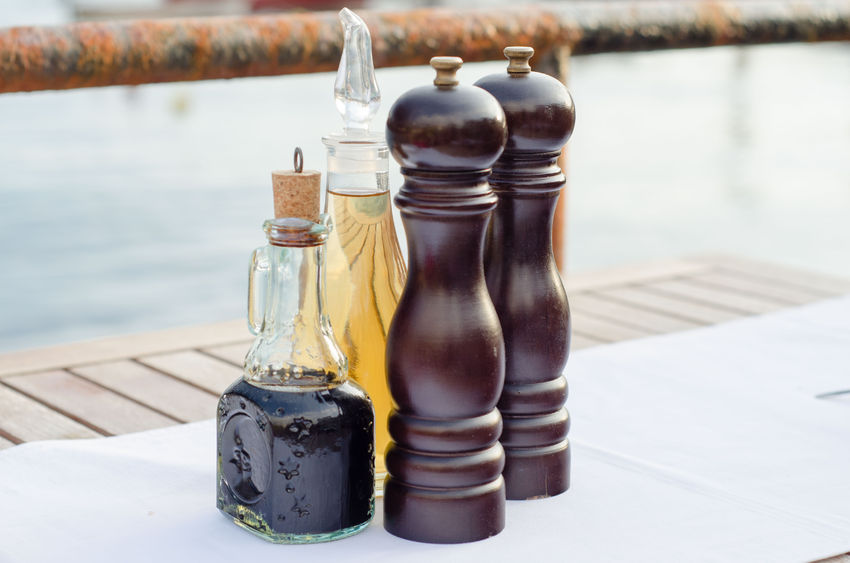Common Condiments and
How to Use Them

Salt and pepper are the most common condiments, but let’s not forget about sauces and relishes. They are found in several varieties and served in packets, bottles, jars, and bowls depending on the dining setting.
Condiments are used to add layers of flavor to a dish, not to be enjoyed as a dish themselves. And while these added seasonings can improve most any meal, there are times when you might refrain from using them at all.
Salt, Pepper, and Other Sprinkles
Salt and pepper go together. No, it’s not just a rhyme. They really do!
Whenever you are asked to, “Pass the salt, please,” you pass the pepper along with it. They always travel the table as a pair. Many times, when salt is added to a dish, pepper will be added as well. But if these two get separated, it can cause a disruption in the meal to stop and look for the missing partner.
Other items used to sprinkle on flavor are sometimes placed on the table during meals, too. This can include various herbs, Parmesan or other cheeses, and spices such as cinnamon and nutmeg.
These extras will be determined by the meal being served. They may be in shakers or small bowls with spoons.
The primary rule with salt, pepper, and other sprinkles is to taste your food first before adding extra flavoring. Always, in any household or restaurant, it should be assumed that the person who prepared the food knows what he’s doing.
To season food before a bite or two is eaten sends the un-etiquette-ful signal that the cook hasn’t prepared the food well or that the food is lacking.
Sauces
In not-so-long-ago days, ketchup was bottled in long-neck glass jars, and much patience was required before it poured out. You had to turn the bottle upside down at a slight angle, giving it a gentle shake.
Hitting the bottle on the bottom was discouraged due to bursts of ketchup. It was the same with steak sauce. The rule always was, “Do not poke your knife, clean or otherwise, into the neck of the bottle.”
Mustard, seasoning sauces, and relishes were in glass jars and sometimes included in a table caddy. The jars had metal lids with carved out places for little spoons which stuck out at the top. It was understood that everyone used the same spoon and the spoons were replaced in the jars. (No licking or wiping with fingers, please.)
Today, “Please pass me the ketchup,” brings an immediate picture to mind. Someone reaches to the caddy on the table and asks, “Mustard, too?”
In very casual sit-down restaurants, having the hot sauce, relish or other condiments already on the table is common. They are generally served in plastic squeeze-operated bottles.
However, in mid-range or less casual restaurants, condiments are not placed on the table unless a burger or similar meal is ordered. You will need to ask your server for ketchup or steak sauce if you prefer it.
To use the sauce of your choice, pour or dip onto your plate just enough to enjoy with your food. As you cut a bite, dip it in the sauce and then eat.
In the case of salad dressings, pour or dip the dressing onto your salad. Lightly and gently toss your salad, to mix in the dressing. If there are large pieces of lettuce or other vegetables on your plate, cut them using your fork and knife as you mix the salad. Once this task is complete, place your knife at the top of your plate and eat the salad with your fork.
In upscale restaurants, if a sauce accompanies a certain dish it will be served with that dish “on the side” in a small bowl with a spoon or a pouring spout. But the chef decides the best accompaniment.
If, after a few bites, you wish to quietly ask your server for a particular sauce, it is fine.
The same is true when attending a gala lunch or dinner. These events are typically catered, so only a limited variety of condiments will be available, if at all.
Dining at Home
The choice of condiments placed on the table at home is up to the cook and head of household. When you are a guest in someone’s home, always take a bit or two of the food before requesting a condiment.
It is also important to teach your children this habit. When they visit a friend or family member’s home, they will be recognized as a good guest if they extend this respect to the person who prepared their meal.
In your own home, you can recognize your child’s individuality by allowing him or her to place condiments of choice on the table as it is also set with dinnerware. This exhibits mutual respect and teaches your child the helpful task of setting a table.














